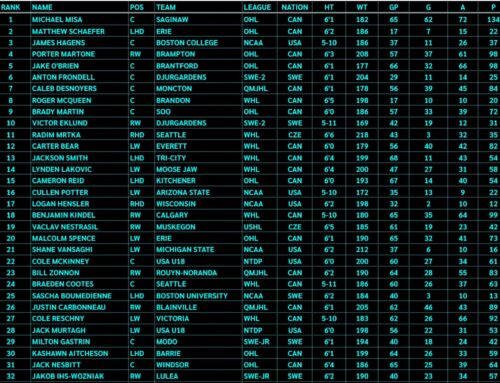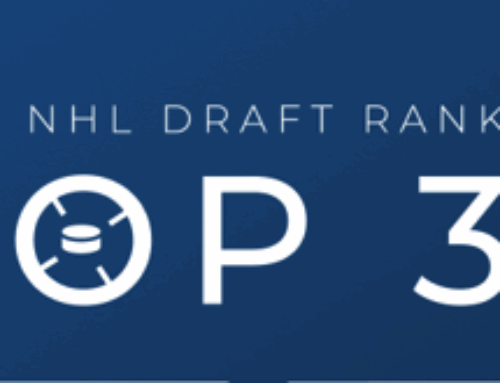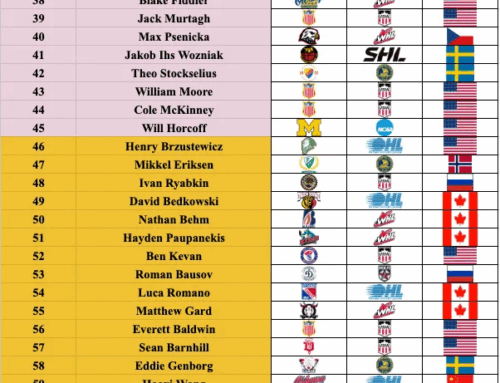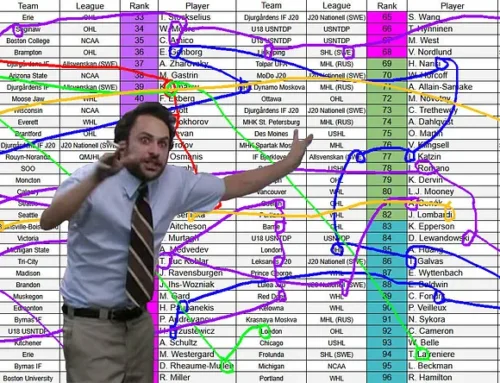March NHL Draft Report: Where We Go From Here
Tony Ferrari
2020-04-02
March Draft Report is a monthly column that highlights a number of topics in the NHL Draft world at the time. Each month will have the main feature story, a themed ‘Team of the Month’ and a Prospect Spotlight that takes a bit of a deeper look at a player. This month we are taking a look at what the stoppage in play means for the scouting world, we put together the ‘All-Overage Team’ and we put a spotlight on the smart and steady Eamon Powell.
The month of March is coming to a close and we are without hockey, and sports in general, for the foreseeable future thanks to COVID19. My Dobber Prospects colleague Brayden Olafson gave a great look at how things changed with immediate reaction to everything right after it happened. Now, we are a few weeks into things and many seasons have been canceled from the USHL and CHL, Memorial Cup included, to many of the European leagues. The NHL Draft and everything with it has been postponed and NHL teams still have no idea if a return to play this season is even reasonable.
So now the question being asked by many is “What does the draft world do now?” and what does everyone do now? There have even been questions as to whether outlets, Dobber Prospects included, will continue putting out content.
Let’s start with the latter question. The team here at Dobber Prospects will not only be continuing to produce the excellent content that we always strive to provide but we will have more in-depth deep dives, interviews with players from Europe to North America, we will be adding an updating the 2020 draft profiles and we will be able to produce some excellent feature work. You can rely on us to help pass the time during isolation and physical distancing.
As for the initial question about what the draft work does now, that’s what we are going to look at this month in the NHL Draft Report. We are going to cover what changes in our plans, what we are doing now that there are no new games and how this could actually result in one of the best-covered drafts in the history of the sport.
What Changes In Our Plans?
To be honest, this is the easy part. The simple answer is not much. We work to the draft, whenever that may be and then pretend to take a few days off before we get into next years crop. That is still the plan for many of us. This Draft Report will continue to come out monthly, most analysts in the draft world will still continue doing their thing by putting out their content, providing whatever insight they can and studying the players in this draft.
The one big change that does affect many of us that we won’t be attending games and seeing live hockey for quite some time possibly. While I will always say that scouting on video is a wonderful way to get views on players all over the world, there is something to being there in person. It provides a bit of a more accurate feel for the game. This isn’t to say that the in-person viewings are superior or that the people who can’t get to arenas and rinks to court can’t do just as good a job, or better. The lack of in-person viewings puts everyone on a level playing field. The entire scouting community is doing ALL of their scouting in video form from here on out. Now it’s time to see who puts in that extra work.
No New Games? No Problem
The reality of the situation is that there are no new games and we all have to adjust to that. Watching old games will be a key factor in continuing to scout these players. One thing that we will all have to take into consideration is that we have to be cognizant of when the game we are watching is played. Was it in October before the player really found their footing? Was it during that mid-January hot-streak? Maybe it was right before the season was canceled and the player just returned from injury. These will all be things we will have to consider.
One of the methods that we can try to get a full picture of a player without any new games is to watch try and watch a game from each month of the season. Try and figure out where they grew and how their progression over the season played out. Was the player struggling to find chemistry with teammates in November but found his footing when out with a new line? Maybe a CHL import came over to North America and excelled upon his arrival but seemed to wear down as the year went on. Watching a variety of games from a player’s season is key to understanding how much they developed and whether they’ve made progress on the weaknesses they began the year with.
No scout or analyst has seen every game that a player has played which gives all of us a good selection of games to choose from. With hindsight, we can take a look at how a player looked when his team was blown out 10-2. How involved was he in a tight 1-0 game? Was he able to make an impact in games he was held off the scoresheet? We always took a look back and do exercises like this with players we want to get a grasp on and generally, at the end of the year, we have a few players that we wish we had a chance to get those extra looks on. Now with many of us home on isolation, physical distancing or even just working from home, we will have all the extra time that we would have usually spent on the commute to work or driving to and from arenas.
The Best Covered Draft Ever
Smaller sample sizes due to incomplete seasons and a complete void of playoffs in many leagues would tend to lead to the thought that the prospects in this draft could be given a raw deal in terms of an opportunity to impress. The issue with that argument is that the vast majority of these players have played anywhere from 40 to 60+ games and that sample size should be more than enough, combined with any past season exposure, to come up with an opinion on a player both analytically and from watching the tape.
The key to this year’s draft being one of the best cover drafts ever is that scouts and analysts alike have the opportunity to NOT go to games for once. As previously mentioned, there are definitely some advantages to getting in-person viewing on players such as a better feel for the game and the opportunity to watch how a player interacts and deals with situations on the ice that you don’t see watching whatever camera angle is available when watching game tape. The experience and exposure to the game in person is a bonus for scouts and media who cover these games and the young athletes but it isn’t a necessary requirement for a good analyst to get a feel for a players game.
We all now get the chance to sit at our workstation of choice and go back and watch games that we wouldn’t have been able to. Watching archived games can be helpful because we are able to skip through commercials and intermissions, cutting the time needed to watch a game down significantly. With the season still underway, many of us would be travelling to and from games on weekends and the occasional weeknights and the NHL scouts would be doing the same and more. With physical distancing having been the best way to deal with the COVID-19 pandemic, many of us are home and utilizing technology at a rate we never previously have because it is being forced upon us.
This massive shift in the way we all do things has the opportunity to change the future of the practice of scouting and player evaluation. Video work that is done on a professional level will be ramped up. That same video will be what media, analysts and anyone interested in the draft will have at their disposal if they can get access to a number of online streaming services that the leagues have put together from the CHL Live streaming services to Ruutu and Svensk hockey in Europe, we will all be focusing our attention in reviewing and utilizing the tools that many of us may have lacked the ambition to embrace prior to it being forced upon us.
With the draft being delayed and our time being spent at home and reviewing game tape online, we have much more time to work on and adjust our evaluations and analysis of prospects prior to the draft. This extra analysis and studying of the prospects will lead to many of us having stronger opinions, more steadfast evaluations and the ability to identify difference makers among the hundreds of junior-aged players that we watch every year. If the draft ends up taking place in August, despite the likelihood of it being over the phone and closed to media, that gives us all two extra months to make judgements, evaluations and work on putting together our lists and rankings. The 2020 NHL Draft has a very good chance of being the best-covered draft ever. Now let’s get to some real hockey talk!
All-Overaged Team
LW Dmitri Sheshin – C Kristian Tanus – RW Evgeniy Oksentyuk
D Adam Wilsby – D Billy Constantinou
G Amir Miftakov
The All-Overaged team is a mixture of players that have been passed over for a variety of reasons from playing in a country that lacked coverage to having one serious flaw that hindered teams view of the player. All six of these players have a real shot at being drafted this season and if they do not, a couple of them may sign with and NHL team as an undrafted free agent.
Starting from the net out, the battle for the crease on the All-Overaged team was the most hotly contested with three real options in Nico Daws, Samuel Hlavaj and Amir Miftakov but the nod went to the young Russian. Amir Miftakov has been a stud for the last few seasons in the VHL after dominating the MHL prior to that. His numbers all indicate that he has been one of the better Russian netminding prospects in recent years but he hasn’t been drafted. The main culprit behind that has been his height. At just 6’0″, he is undersized for what NHL teams seek in a goaltender but the resume that Miftakov has brought to the table is almost too good to pass up. He has put up a .914 and .919 save percentage the last two seasons in the VHL. He has been a part of two medal-winning World Junior Championship teams for his home nation of Russia and he helped lead the Russians to the gold medal game this year after Yaroslav Askarov seemed to be in a bit over his head this past December and January. Miktakov could opt to stay in Russia longterm but he is worth a lottery ticket for an NHL team as he does nothing but stops pucks and lead his team to success.
The defenders on this team are offensively inclined and will definitely be a liability in their own end but this team is built to play a fun and high-paced game that outguns their opponents and these two defensemen can act as fourth and fifth forwards in the offensive zone. Adam Wilsby is on his final go-around at the draft this year and it may finally be his year after an impressive offensive season in the Allsvenskan. He put up 30 points in 41 games doing an excellent job of moving the puck up ice and facilitating in the offensive zone. He shows potential to possibly be a second powerplay quarterback and play sheltered third pair minutes at even strength. He is an excellent skater and provides the offensive skills to intrigue teams but he will certainly need work on his own zone.
The second defender on the team is Billy Constantinou of the Soo Greyhounds in the OHL. The reason for him going undrafted primarily had to do with the fact that he was traded to the Kingston Frontenacs last season and never really seemed to fit in. That issue continued into this season and resulted in a trade to the Soo Greyhounds where Constantinou finally seemed to find the footing he was developing in Niagara before being dealt to the Frontenacs early last season. To say he’s been around is an understatement as he has played games for three different OHL teams in the last two seasons. The draw for NHL teams will be the young blueliner’s ability to skate and move pucks. Much like Wilsby, Constantinou is a skilled defender in the offensive zone and he may even be a bit more dynamic in transition. His ability to visualize the play and drive the play from the backend is impressive. The video above shows his willingness to attack from the blueline and his vision in the offensive zone as he sets up a nice goal with a sweet dish.
As we move to the forward group, we have a group of European players who were overlooked last season for a variety of reasons. Oksentyuk had some pretty sizable skating issues and he played in Belarus where the offensive skill that was attached to that poor skating wasn’t seen. He plays a tenacious game and doesn’t run from anyone. He attacks the opposition with vigor and speed and his hands are impressive to say the least. His improved skating should help warrant a selection in the top-100 of this year’s draft. Th video above is from a game in January when the brash Belarusian forward pulled off “The Michigan” or “Lacrosse Goal”. The moonwalk to cap it made it even better. Kristain Tanus was an undersized center that some believe he won’t translate to the NHL. He showed well in his limited Liiga time this year and his performance at the U20 level internationally has been impressive with 21 points in 13 contests across various events, including nine points in seven games at the World Juniors. Rounding out the forward group is left winger Dmitri Sheshin who plays in the MHL in Russia and finished fourth in league scoring with 71 points in 61 games. He was passed over last season after putting up almost a point-per-game in the MHL for little reason other than Russia, and Europe in general, often gets overlooked and teams hesitate from drafting overseas at times. Sheshin is a good skater who can get a bit greasy along the boards. He has found a bit more of a scoring touch this season which is exactly the development path you’d like to see for his draft+1 year.
Eamon Powell: Quietly Effective and Improving
The U.S. NTDP team has been producing NHL talent on a consistent basis over the last number of years and this season is no different. While there aren’t the high-end players that last year’s team featured, there are a number of players that look to have long and productive careers in front of them. Jake Sanderson has taken up most of the headlines on the backend and players like Thomas Bordeleau and Ty Smilanic have taken the brunt of the press in the forward group. The player that’s quietly been one of the top players on this year’s U18 team doesn’t get the same kind of praise and attention despite being one of the most consistent players from start to finish. Eamon Powell is a smooth-skating, intelligent two-way defender who can impact the game at both ends of the ice when at his best. Powell will get drafted later than he should and whatever team lands the young American right-handed blueliner.
Taking a look at Powell’s statistical performance this season, it doesn’t blow you away right off the bat. In 43 games with the NTDP team in all competitions, he has been limited to 14 points. The total isn’t terrible for a defender but more is generally expected from a player who could go in the top three rounds of the NHL draft. The numbers start to look a bit better when looking at his games against just the USHL competition. His 11 points in 19 games are much closer to what is desired when talking about a top-half of the draft defender.
Powell’s strength is that he is an extremely intelligent player. He thinks the game at a high-pace which allows him to read and react to the play as it unfolds, rarely leaving himself out of position. When defending on the rush, Powell does an excellent job of checking his shoulder, ensuring that he is aware of every player in on the rush for the opposition and reacts appropriately. His gap control is excellent, oftentimes stepping up on attackers at or before they reach the blueline. He is aggressive in the way that he defends the blue line in that he is consistently pressuring the opponent to make a play or dump the puck in far earlier than the attacking player would like. In the play below, Powell (#2 in blue) reads that the play is going to be heading back towards his end of the ice and he gets a jump on getting back defensively. At that point he allows space through the neutral zone and then as soon as the forward crosses the blueline, Powell gives him no space and forces a simple dump in. He tracks the player down the boards and the vacates to the front of the net. Simple plays like this seem insignificant at the time but preventing the opposition from getting set up is the type of preventative defense that is effective in the modern game.
Powell’s skating is his best physical tool. He has an effortless stride and excellent agility. This is partially what makes him an effective player in the neutral zone, both offensively and defensively. In the video below, Powell’s skating is on display. He is effortless in his acceleration and good top-end speed help him win the race to the puck and then his skating along with his vision and IQ allow him to turn it up ice and join the rush. The play doesn’t result in much but that had little, if anything, to do with Powell. His skating is crisp, he makes good, quick decisions with the puck and helps prevent the opposition from generating anything on what could have been an excellent scoring chance.
Powell doesn’t get credit for the offensive upside that he does possess because he isn’t asked to do it often with the U18s because of the presence of players like Sanderson and the team’s insistence on using Kleven on the powerplay despite being limited in that role. When he does see the opportunity, he takes it and flashes the skill that could lead to a more offensive role on a team with less on the backend. In the clip below we see an outstanding offensive chance that is generated by Powell. He reads the play and moves up in the zone as his teammate protects the puck up the wall. He retrieves the puck along the wall and immediately turns back up the wall to give himself some space. When he identifies the open space in the middle of the offensive zone, he attacks it with his quick feet and maintains control of the puck. He evades a couple of defensive players, crossing the middle of the zone before firing a near-perfect backhand pass across his body to the backside of the net. Bordeleau is in position to finish but doesn’t get all of the puck and sends it wide. This type of play isn’t a staple in Powell’s game but it does pop up from time to time, revealing the offensive upside that is there even if it’s just on an occasional basis.
One of Powell’s sneaky-good traits is his shot, specifically from the right faceoff dot. He has a tendency to generate dangerous scoring chances from that area of the ice, consistently pinching in from the point to provide his team an outlet while staying in a dangerous position. In the clip below, we see an outstanding play by Sanderson, Bordeleau, and Powell with #2 putting it in the back of the net from his favorite spot. Sanderson starts the rush with a nice move to evade a forechecker and breakout fo the zone. As he enters the zone, he drops the puck off to Bordeleau before driving towards the net. Bordeleau spots Powell streaking in on the far side and puts a pass on his tape. From there, Powell takes his time, identifies the open corner and beats the goalie clean.
Powell isn’t the most flashy player and he won’t be the dynamic powerplay quarterback that teams covet. He is a steady, smart and mobile defender that has the offensive flair when the moment presents itself. He understands his skill set and how to play off high-end players such as Sanderson. His defensive game is solid and the only real weakness he has as a defender is that he will need to get stronger. This was a primary reason that although he was able to play an efficient and effective game against the NCAA opponents, he wasn’t able to be the consistent difference-maker that he was at the USHL level. Powell has been the NTDP’s second-best defender for much of the year with only Sanderson eclipsing his play. Powell doesn’t possess the size that many teams want in a defender but he plays a modern, mobile game and will give teams an intelligent hockey mind on the ice whenever he is out there. He projects as a second-pair defender at the NHL level thanks to his high-end mobility and his impressive IQ.
*******
If you have an idea for a feature story for next month, have a suggestion for the ‘Team of the Month’ or prospect spotlight, reach out! Let me know! I can always be reached on Twitter @TheTonyFerrari! Thank you again for reading this, whether you sat down with a pot of coffee and consumed it in one sitting or split it up over a few visits, I appreciate it all!
Make sure you check out the full Dobber Prospects 2020 NHL DRAFT PAGE! There are over 60 player profiles and a ton more draft content including the January Draft Report with a full breakdown of my Top-100 Rankings with video and analysis on 60+ players including nearly every player in the top-40!








